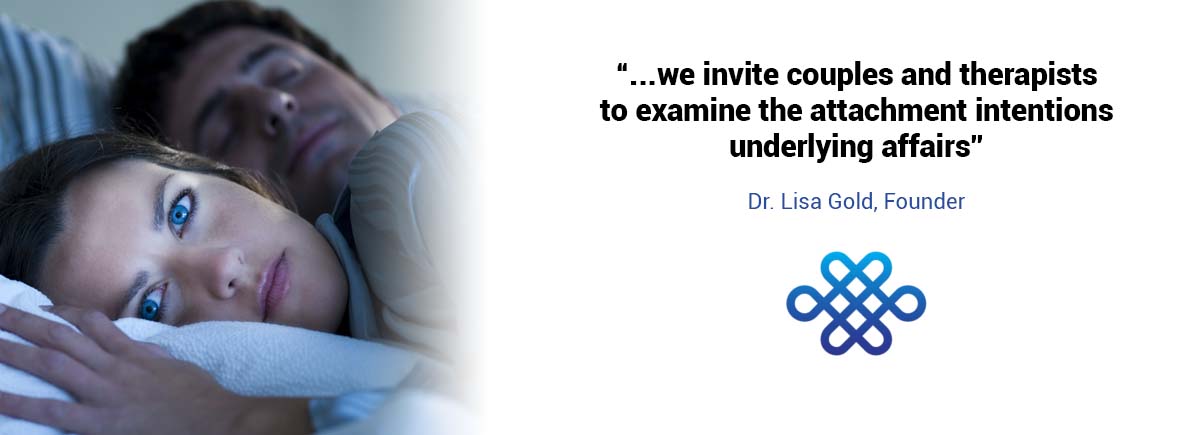From an attachment perspective every behavior and emotional response is understood as an attempt to get attachment needs for love and security met. Even when partners’ actions are destructive to their relationships and don’t seem to correspond with a desire to connect, looking for the attachment intention underlying the destructive behavior provides a clearer picture as to the ontological etiology of those actions. When we understand the irrational and detrimental behavioral and emotional responses as an activation of the amygdala and limbic system to protect against pain and isolation, that which makes no sense at all actually does make sense. The tragedy is that operating on fear, shame, hurt and sadness with a desperation to avoid the pain of isolation, often leads to greater suffering than that which was initially feared. It is from this perspective that we invite couples and therapists to examine the attachment intentions underlying affairs. Doing so provides an opportunity to identify the processes that culminated in reaching outside the primary relationship to meet attachment needs.
These Processes Include:
1) the underlying emotional processes and corresponding unmet attachment needs, as well as
2) the mis-attunement that activated these emotional responses and contributed to the distorted views of self and other as not desiring or capable of meeting each others needs.
In our clinical work, we have found that underlying attachment intentions of affairs can be understood as attempts to:
1) re-engage a partner
2) protect the existing connection with the partner,
3) protect against feared potential abandonment,
4) defend against the pain of potential rejection and negative view of self,
5) exit from pain being experienced as a result of perceived abandonment or rejection from the partner,
5) numb painful primary emotions unrelated to the primary relationship partner,
6) emotionally or physically exit the relationship after losing all hope of creating the desired connection with the primary partner, and
7) prevent becoming dependent or vulnerable with the primary partner.
These underlying attachment intentions cluster into six identifiable patterns or types of affairs:
1) the Angry Protest Affair,
2) the Come and Get Me Affair,
3) the Burned Out Affair,
4) the Hedge Fund Affair,
5) the Fantasy Escape Affair, and
6) Power Player Affair.
These types of affairs differ in terms of the attachment strategies and the partners’ patterns of interaction prior to the affair. Understanding these differences can help the couple and the therapist to have a more accurate map of where the couple has been, but also of where they want to go and how they can effectively get there.

We intentionally did not create a type of affair to address whether or not the affair was emotional, sexual or both. Nor did we create a type of affair that addresses sexual compulsivity, trauma or domestic violence. The reality is that the degree of emotionality, sexuality, sexual compulsivity or abuse are all dimensions of each type of affair, rather than being types in and of themselves. It is important to assess for and address these dimensions. We recommend assessing and treating these dimensions within the framework of understanding the attachment intention and the corresponding behavioral and emotional responses of the particular type of affair. In our work with our clients, we have found that this framework provides a more effective way of identifying and treating the multi-dimensional aspects of partners individual and relational patterns of emotional processing and action tendencies. It provides a more detailed map with an understanding of how all the parts of the puzzle interact and have culminated into the couples’ present day relationship patterns. It provides a map of where each partner has been, where they have been together, where they are now and how to help them get where they would like to go from here.
The constructs of these different types of affairs can assist couples and their therapists with developing a cohesive narrative about how the unfaithful partner became vulnerable to and eventually succumbed to having an affair. Both partners need to have a shared understanding of this in order for the betrayed partner to take the risk of developing trust in the unfaithful partner. This shared narrative is also important in assisting the betrayed partners continue to deepen their trust in their partners. Developing a shared understanding of how the affair happened helps couples to establish mutually agreed upon strategies for actively protecting their relationship from further breaches of trust. Their relationship becomes safe because they develop a pattern of turning to one another to meet their needs for connection, instead of turning outside of their relationship.
Without understanding how the affair happened, it is difficult for the betrayed partner to develop trust in the unfaithful partner’s ability to promise that it will never happen again. It can also be difficult for the unfaithful partner to feel confident promising that it won’t happen again if the unfaithful partner doesn’t understand how or why the affair happened. Without understanding the hows and whys of the affair, partners are likely to adopt the most common narratives our culture offers about how and why people cheat. These popular narratives are likely to perpetuate the partners’ distorted views of themselves, one another, and relationships that contributed to their relationship being vulnerable to infidelity.
Not only are these narratives inaccurate, but they are damaging since they usually pit men and women against each other and portray one or both of the partners as being fundamentally untrustworthy or unworthy of love. Believing these inaccurate and destructive narratives not only makes it more difficult for couples to heal and develop trust in one another after an affair, it also makes couples more vulnerable to future infidelity and perpetual distrust in each other’s love. Trust cannot be established if one or both partners view the other as fundamentally untrustworthy by virtue of that partner’s gender or fixed character, or if one or both partners subscribe to the myth that infidelity is an inevitable part of a relationship. Unless couples are assisted to extract these popular cultural narratives from their own narrative, they are at risk for clinging to their fears rather than taking the risk of reaching for connection. Anchoring them in an attachment perspective facilitates their ability to create safety in their relationship and move forward with a secure attachment bond.
Can A Marriage Survive Infidelity WITHOUT Counseling?
Some relationships can not survive an affair. Other couples are able to repair their relationships with couples counseling for infidelity or on their own. When one partner cheats on the other, it may leave the partner that has been cheated on feeling confused, betrayed, emotionally crushed, and alone.












